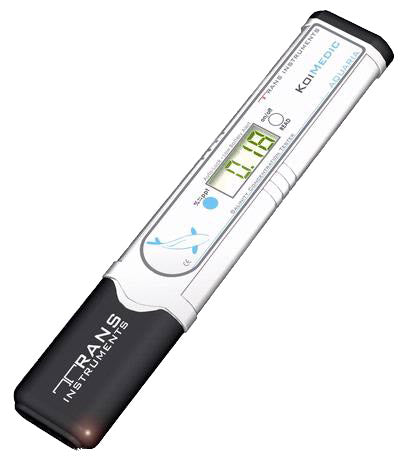KoiMedic - Your Koi pond's Care Taker
KoiMedic is specially designed to measure the delicate salt concentration in the pond. The tester can display measurement in percentage (%) or parts per thousand (ppt).
The tester is easy to use and accurate. It is the best companion for Koi or fish requiring the tonic of salt to improve health.
Advanced Features:
- Display reading in % or ppt.
- One touch calibration.
Specifications
| Model: | KoiMedic | |
| Units of measurement | % | ppt |
| Range: | 0.00 to 1.00% | 0.0 to 10.0 ppt |
| Resolution: | 0.01% | 0.1 ppt |
| Accuracy: | ± 0.03% | ± 0.3 ppt |
| Battery Type: | 4 x 1.5V button cell (Alkaline A76 or equivalent) | |
| Battery Life: | Approx. 150 hours | |
| Automatic Temperature Compensation: | 0 to 50°C or 32 to 122°F | |
| Packaging Dimension Size (LxWxH): | 185mm x 65mm x 25mm | |
| Packaging Weight: | Approx. 135gm | |
| Product Dimension Size (LxWxH): | 170mm x 32mm x 15mm | |
| Product Weight: | Approx. 70gm | |
Prevention is Better than Cure!
Common salt, Sodium Chloride (NaCl) is commonly used in the health care and maintenance of fishes especially Koi. Salt is useful in eliminating parasites. It will eliminate seven out of nine types of parasites that are commonly found in Koi ponds.
Most fish have an internal salt concentration of 1.0% or 10 parts-per-thousand (ppt) which is higher than their water environment. Osmosis causes water to transfer from the lower salinity of the pond water into the tissues of the fish. Addition of salt will lower the osmosis pressure. This reduces the effort of the fish in eliminating the excess water. The saved energy is then available for use by the fish’s own immune system to fight diseases. On the other hand, if the salinity of the water environment is close to the internal tissues of the fish, the osmosis pressure will reverse and cause the fish to die of dehydration.
Salt concentrations of between 0.3% and 0.5% (3 to 5ppt) will upset the osmotic balance of some parasites i.e. the parasites’ cells will dehydrate. Salt concentration of 0.3% are effective at detoxifying nitrite and concentrations of 0.25% or higher have been used to control string algae. Nevertheless, salt can cause pond plant damage as the concentration increases. Floating plants (water hyacinth, water lettuce, etc.) are affected at lower concentrations than most bog plants.

